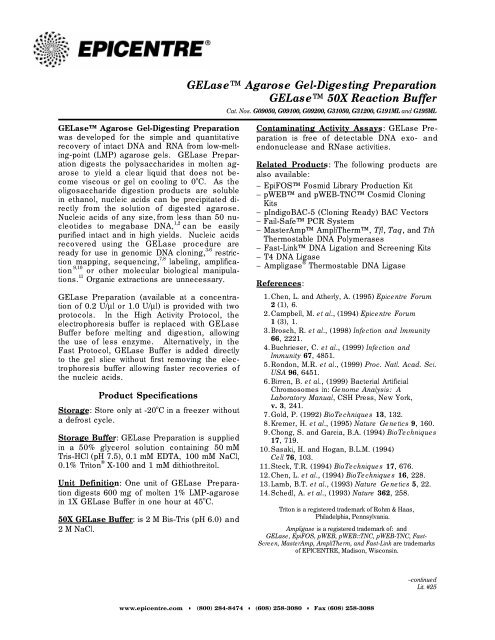Protocol for GELase⢠Agarose Gel-Digesting Preparation and ...
Protocol for GELase⢠Agarose Gel-Digesting Preparation and ...
Protocol for GELase⢠Agarose Gel-Digesting Preparation and ...
Create successful ePaper yourself
Turn your PDF publications into a flip-book with our unique Google optimized e-Paper software.
GELase <strong>Agarose</strong> <strong>Gel</strong>-<strong>Digesting</strong> <strong>Preparation</strong><br />
GELase 50X Reaction Buffer<br />
Cat. Nos. G09050, G09100, G09200, G31050, G31200, G191ML <strong>and</strong> G195ML<br />
GELase <strong>Agarose</strong> <strong>Gel</strong>-<strong>Digesting</strong> <strong>Preparation</strong><br />
was developed <strong>for</strong> the simple <strong>and</strong> quantitative<br />
recovery of intact DNA <strong>and</strong> RNA from low-melting-point<br />
(LMP) agarose gels. GELase <strong>Preparation</strong><br />
digests the polysaccharides in molten agarose<br />
to yield a clear liquid that does not become<br />
viscous or gel on cooling to 0 o C. As the<br />
oligosaccharide digestion products are soluble<br />
in ethanol, nucleic acids can be precipitated directly<br />
from the solution of digested agarose.<br />
Nucleic acids of any size, from less than 50 nucleotides<br />
to megabase DNA, 1,2 can be easily<br />
purified intact <strong>and</strong> in high yields. Nucleic acids<br />
recovered using the GELase procedure are<br />
ready <strong>for</strong> use in genomic DNA cloning, 3-6 restriction<br />
mapping, sequencing, 7,8 labeling, amplification<br />
9,10<br />
or other molecular biological manipulations.<br />
11 Organic extractions are unnecessary.<br />
GELase <strong>Preparation</strong> (available at a concentration<br />
of 0.2 U/µl or 1.0 U/µl) is provided with two<br />
protocols. In the High Activity <strong>Protocol</strong>, the<br />
electrophoresis buffer is replaced with GELase<br />
Buffer be<strong>for</strong>e melting <strong>and</strong> digestion, allowing<br />
the use of less enzyme. Alternatively, in the<br />
Fast <strong>Protocol</strong>, GELase Buffer is added directly<br />
to the gel slice without first removing the electrophoresis<br />
buffer allowing faster recoveries of<br />
the nucleic acids.<br />
Product Specifications<br />
Storage: Store only at -20 o C in a freezer without<br />
a defrost cycle.<br />
Storage Buffer: GELase <strong>Preparation</strong> is supplied<br />
in a 50% glycerol solution containing 50 mM<br />
Tris-HCl (pH 7.5), 0.1 mM EDTA, 100 mM NaCl,<br />
0.1% Triton ® X-100 <strong>and</strong> 1 mM dithiothreitol.<br />
Unit Definition: One unit of GELase <strong>Preparation</strong><br />
digests 600 mg of molten 1% LMP-agarose<br />
in 1X GELase Buffer in one hour at 45 o C.<br />
50X GELase Buffer: is 2 M Bis-Tris (pH 6.0) <strong>and</strong><br />
2 M NaCl.<br />
Contaminating Activity Assays: GELase <strong>Preparation</strong><br />
is free of detectable DNA exo- <strong>and</strong><br />
endonuclease <strong>and</strong> RNase activities.<br />
Related Products: The following products are<br />
also available:<br />
− EpiFOS Fosmid Library Production Kit<br />
− pWEB <strong>and</strong> pWEB-TNC Cosmid Cloning<br />
Kits<br />
− pIndigoBAC-5 (Cloning Ready) BAC Vectors<br />
− Fail-Safe PCR System<br />
− MasterAmp AmpliTherm, Tfl, Taq, <strong>and</strong> Tth<br />
Thermostable DNA Polymerases<br />
− Fast-Link DNA Ligation <strong>and</strong> Screening Kits<br />
− T4 DNA Ligase<br />
− Ampligase ® Thermostable DNA Ligase<br />
References:<br />
1.Chen, L. <strong>and</strong> Atherly, A. (1995) Epicentre Forum<br />
2 (1), 6.<br />
2.Campbell, M. et al., (1994) Epicentre Forum<br />
1 (3), 1.<br />
3.Brosch, R. et al., (1998) Infection <strong>and</strong> Immunity<br />
66, 2221.<br />
4.Buchrieser, C. et al., (1999) Infection <strong>and</strong><br />
Immunity 67, 4851.<br />
5.Rondon, M.R. et al., (1999) Proc. Natl. Acad. Sci.<br />
USA 96, 6451.<br />
6.Birren, B. et al., (1999) Bacterial Artificial<br />
Chromosomes in: Genome Analysis: A<br />
Laboratory Manual, CSH Press, New York,<br />
v. 3, 241.<br />
7.Gold, P. (1992) BioTechniques 13, 132.<br />
8.Kremer, H. et al., (1995) Nature Genetics 9, 160.<br />
9.Chong, S. <strong>and</strong> Garcia, B.A. (1994) BioTechniques<br />
17, 719.<br />
10.Sasaki, H. <strong>and</strong> Hogan, B.L.M. (1994)<br />
Cell 76, 103.<br />
11.Steck, T.R. (1994) BioTechniques 17, 676.<br />
12.Chen, L. et al., (1994) BioTechniques 16, 228.<br />
13.Lamb, B.T. et al., (1993) Nature Genetics 5, 22.<br />
14.Schedl, A. et al., (1993) Nature 362, 258.<br />
Triton is a registered trademark of Rohm & Haas,<br />
Philadelphia, Pennsylvania.<br />
Ampligase is a registered trademark of: <strong>and</strong><br />
GELase, EpiFOS, pWEB, pWEB::TNC, pWEB-TNC, Fast-<br />
Screen, MasterAmp, AmpliTherm, <strong>and</strong> Fast-Link are trademarks<br />
of EPICENTRE, Madison, Wisconsin.<br />
−continued<br />
Lit. #25<br />
www.epicentre.com • (800) 284-8474 • (608) 258-3080 • Fax (608) 258-3088
EPICENTRE<br />
GELase <strong>Agarose</strong> <strong>Gel</strong>-<strong>Digesting</strong> <strong>Preparation</strong><br />
GELase 50X Reaction Buffer<br />
General Considerations<br />
1. Type <strong>and</strong> Source of <strong>Agarose</strong>: Generally, any high quality Low Melting Point (LMP) agarose developed<br />
<strong>for</strong> molecular biology that remains molten at 45 o C is suitable. Note: agaroses that melt at<br />
higher temperatures are also substrates <strong>for</strong> GELase enzyme. However, exposure of nucleic acids<br />
to the high temperatures required to melt agarose will denature double-str<strong>and</strong>ed DNA <strong>and</strong> degrade<br />
RNA. If the use of a high melting point agarose is necessary <strong>for</strong> resolution <strong>and</strong> non-denatured<br />
DNA is required, cut a hole in the gel below the b<strong>and</strong> of interest <strong>and</strong> fill with LMP agarose.<br />
Transfer the nucleic acid into the LMP agarose plug by electrophoresis <strong>and</strong> treat the LMP-agarose<br />
plug with GELase enzyme. 11<br />
2. <strong>Gel</strong> Electrophoresis Conditions: The presence of borate ions can detrimentally affect the activity<br />
of many enzymes (including GELase enzyme). There<strong>for</strong>e, we recommend using TAE <strong>for</strong> gel electrophoresis<br />
if the recovered DNA is to be used in subsequent applications without purification or<br />
concentration.<br />
3. Choosing between the Fast <strong>and</strong> High Activity <strong>Protocol</strong>s: Two protocols are described that differ<br />
by the inclusion of a buffer exchange step. The High Activity <strong>Protocol</strong> achieves optimal enzymatic<br />
activity through exchange of the electrophoresis buffer with GELase Buffer, thereby allowing the<br />
use of less enzyme. Conversely, the Fast <strong>Protocol</strong> allows recovery of nucleic acids in the shortest<br />
time possible by omission of the buffer exchange step, but more enzyme is required. Use the<br />
Fast <strong>Protocol</strong> when purifying very small nucleic acids (
EPICENTRE<br />
GELase <strong>Agarose</strong> <strong>Gel</strong>-<strong>Digesting</strong> <strong>Preparation</strong><br />
GELase 50X Reaction Buffer<br />
Undigested gel remains<br />
Troubleshooting <strong>Agarose</strong> Digestion Reactions<br />
1) Ensure the gel slice is thoroughly melted. Increase the gel slice melting <strong>and</strong> monitor melting<br />
by pipetting the molten agarose. Do not flick or invert the tube which may cause the molten agarose<br />
to solidify on the side or top of the tube. Transfer the molten agarose immediately to 45 o C.<br />
2) Increase the amount of enzyme in the reaction. Calculate the amount of enzyme required using<br />
the relationship outlined in General Considerations, pg. 2. Note that additional enzyme is required<br />
if per<strong>for</strong>ming the digestion in any buffer other than 1X GELase Buffer. For more efficient<br />
digestion, cut large pieces of gel (≥ 1 gram) into smaller pieces <strong>and</strong> digest in separate tubes. Alternatively,<br />
digest large pieces of gel in a single tube <strong>and</strong> occasionally stir the suspension (while<br />
keeping the tube at 45 o C) to ensure complete access of the enzyme to the substrate.<br />
3) Increase the length of digestion. Check that the digestion was per<strong>for</strong>med at the appropriate<br />
temperature, <strong>and</strong> that the tube was completely submerged in the waterbath. Increase the time of<br />
digestion by 15-30 minutes.<br />
4) Equilibrate the molten agarose at 45 o C be<strong>for</strong>e addition of GELase enzyme. GELase enzyme<br />
quickly loses activity at temperatures above 45 o C. Ensure that the molten agarose equilibrates to<br />
45 o C be<strong>for</strong>e adding the enzyme.<br />
5) Resuspend the nucleic acids <strong>and</strong> recover by centrifugation. If the amount of gel in the nucleic<br />
acid pellet is small, redigestion may be unnecessary. Resuspend the nucleic acid in an appropriate<br />
volume of TE or water <strong>and</strong> spin the tube <strong>for</strong> 2-3 minutes in a centrifuge. Transfer the nucleic<br />
acid to a clean tube.<br />
6) Check the type <strong>and</strong> age of the agarose. <strong>Agarose</strong> may degrade with time (> 5 years) resulting in<br />
polysaccharides that are resistant to cleavage. In addition, agarose-acrylamide mixtures are not<br />
efficiently digested by the GELase enzyme.<br />
Recovery of nucleic acids is poor<br />
1) Ethanol precipitate overnight at room temperature. The recovery of small DNA <strong>and</strong> RNA molecules<br />
(£ 500 bp) <strong>and</strong> small quantities of nucleic acids (£ 0.5 mg/ml) is improved by ethanol precipitating<br />
overnight at room temperature. Pellet the nucleic acids by centrifugation <strong>for</strong> 30 minutes at<br />
room temperature.<br />
2) Remove ethanol from nucleic acid pellets carefully. Nucleic acids precipitated in the presence<br />
of ammonium acetate <strong>for</strong>m loose pellets that are easily dislodged from the side of the tube. Do<br />
not pour off the ethanol, but carefully remove the supernatant using a pipet.<br />
3) Prepare fresh ammonium acetate solution. The molarity of the ammonium acetate solution is<br />
critical <strong>for</strong> efficient precipitation of the nucleic acid. We recommend preparing ammonium acetate<br />
solutions by the addition of ammonium hydroxide to glacial acetic acid to pH 7.0, followed by filter<br />
sterilization. Store the solution at 4 o C.<br />
page 5 1/05
















